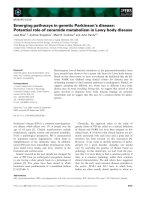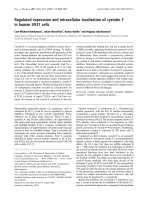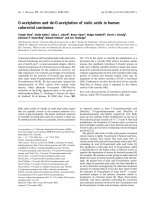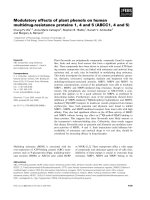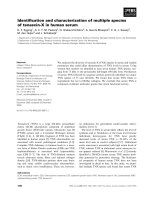Effects of Electrical Current in Human Body
Bạn đang xem bản rút gọn của tài liệu. Xem và tải ngay bản đầy đủ của tài liệu tại đây (49.58 KB, 1 trang )
Product Safety and Quality
Mechanical and Machinery Equipment
Field Evaluation Services
EFFECTS OF ELECTRICAL CURRENT IN THE HUMAN BODY
Current Reaction
Below 1 Milliampere Generally not perceptible
1 Milliampere Faint Tingle
5 Milliampere Slight shock felt. Not painful but disturbing. Average individual can
let go. Strong involuntary reactions can lead to other injuries.
6 to 25 Milliampere (women) Painful shocks. Loss of muscle control.
9 to 30 Milliampere (men) The freezing current or “let go” range. If extensor muscles are
excited by shock, the person may be thrown away from the power
source. Individuals cannot let go. Strong involuntary reactions can
lead to other injuries.
50 to 150 Milliamperes Extreme pain, respiratory arrest, severe muscle reactions. Death is
possible.
1.0 to 4.3 Amperes Rhythmic pumping action of the heart ceases. Muscular contraction
and nerve damage occur; death is likely.
10 Amperes Cardiac arrest, severe burns, death is probable.
Use your electrical smarts and follow these safety Do’s and Don’ts:
Do’s Don’ts
ü Only use plugs that fit the outlet.
ü Make sure that electrical connections are tight.
ü Check that the wire insulation is in good condition.
ü Keep machines and tools properly lubricated.
ü Use extension cords only when necessary and only if they are
rated high enough for the application.
ü Use waterproof cords outside.
ü Only use approved extension lamps.
ü Leave at least 3 feet of workspace around electrical
equipment for instant access.
ü Keep your work area clean. Be especially careful with oily
rags, paper, sawdust, or anything that could burn.
ü Follow manufacturer’s instructions for all electrical
equipment.
ü Leave electrical repairs to skilled maintenance personnel and
licensed electricians.
ü Don’t overload outlets or
motors.
ü Don’t let grease, dust, or dirt
build up on machinery.
ü Don’t place cords near heat or
water.
ü Don’t run cords along the floor
where they can be damaged.
ü Don’t touch anything electric
with wet hands.
ü Don’t put anything but an
electric plug into an electric
outlet.
ü Don’t use temporary wiring in
place of permanent wiring.
If the equipment that in installed within your jurisdiction is not NRTL-Listed, AHJ inspectors
are well advised to be more vigilant about the hazards of electric shock and should require a
third-party inspection by an accredited test Lab.
For more information, Please contact TUV Rheinland of North America, Inc.
12 Commerce Road
Newtown, CT 06470
TEL: 203-426-0888 / FAX: 203-426-4009
Email: or call 1-TUV-RHEINLAND


